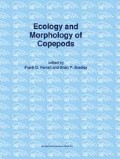Abstract
Gladioferens imparipes,a calanoid copepod from estuaries in Western Australia, displays behaviour and associated morphology which is unusual among calanoids. Adult and copepodid stages make temporary attachment to underwater surfaces using fine hair sensillae on the surface of the prosome. A clear pattern can be seen in the number and arrangement of hair sensillae in early copepodid stages. Line drawings, photomicrographs and an S.E.M. are used to illustrate the structures. Laboratory studies with live copepods in a flow chamber show that adult animals may hold position against water currents. It is hypothesized that this behaviour influences the distribution pattern in an estuary where low velocity tidally induced water movement occurs, and may be of value in enabling the copepod to exist beyond the distribution of a major predator.
Access this chapter
Tax calculation will be finalised at checkout
Purchases are for personal use only
Preview
Unable to display preview. Download preview PDF.
References
Bayly, I. A. E., 1963. A revision of the coastal water genus Gladioferens ( Copepoda: Calanoida). Aust. J. mar. Freshwat. Res. 14: 194–217.
Bayly, I. A. E., 1965. Ecological studies on the planktonic copepoda of the Brisbane River estuary with special reference to Gladioferens pectinatus (Brady) (Calanoida). Aust. J. mar. Freshwat. Res. 16: 315–50.
Castel, J. & J. Veiga, 1990. Distribution and retention of the copepod Eurytemora affinis hirundoides in a turbid estuary. Mar. Biol. 107: 119–128.
Hill, A. E., 1991 a. A mechanism for horizontal zooplankton transport by vertical migration in tidal currents. Mar. Biol. 111: 295–302.
Hill, A. E., 1991b. Vertical migration in tidal currents. Mar. Ecol. Prog. Ser. 75: 39–54.
Fleminger, A., 1973. Pattern, number, variability, and taxonomic significance of integumental organs (sensilla and glandular pores) in the genus Eucalanus ( Copepoda, Calanoida). Fish Bull 71: 965–1010.
Hodgkin, E. R, 1987. The hydrology of the Swan River estuary: salinity the ecological master factor. In J. John, (ed.), The Swan River Estuary, Ecology and Management. Curtin University Environmental Studies Group, Report No. I: 34–44.
Jacoby, C. A. & J. G. Greenwood, 1991. Species-specific variations in emergence of coexisting Stephos and Pseudodiaptomus (Copepoda: Calanoida). Proceedings of the Fourth International Conference on Copepoda; Bull. Plankton Soc. Japan, Spec. Vol. (1991): 405–418.
Ough, K. & I. A. E. Bayly, 1989. Salinity tolerance, development rates and predation capabilities of Sulcanus conflictus Nicholls ( Copepoda: Calanoida). Estuar. coast. mar. Sci. 28: 195–209.
Rippingale, R. J., 1981. The ecology of plankton fauna in saline river pools. Hydrobiologia 82: 223–231.
Rippingale, R. J. & E. P. Hodgkin, 1974a. Predation effects on the distribution of a copepod. Aust. J. mar. Freshwat. Res. 25: 81–91.
Rippingale, R. J. & E. R. Hodgkin, 1974b. Population growth of a copepod Gladioferens imparipes Thomson. Aust. J. mar. Freshwat. Res. 25: 351–60.
Thomson, J. M., 1946. New crustacea from the Swan River estuary. J. Roy. Soc. W.A. 30: 35–53.
Wooldridge, T. & T. Erasmus, 1980. Utilization of tidal currents by estuarine zooplankton. Estuar. coast. mar. Sci. 11: 107–114.
Author information
Authors and Affiliations
Editor information
Rights and permissions
Copyright information
© 1994 Springer Science+Business Media Dordrecht
About this paper
Cite this paper
Rippingale, R.J. (1994). A calanoid copepod Gladioferens imparipes, holding to surfaces. In: Ferrari, F.D., Bradley, B.P. (eds) Ecology and Morphology of Copepods. Developments in Hydrobiology, vol 102. Springer, Dordrecht. https://doi.org/10.1007/978-94-017-1347-4_45
Download citation
DOI: https://doi.org/10.1007/978-94-017-1347-4_45
Publisher Name: Springer, Dordrecht
Print ISBN: 978-90-481-4490-7
Online ISBN: 978-94-017-1347-4
eBook Packages: Springer Book Archive

